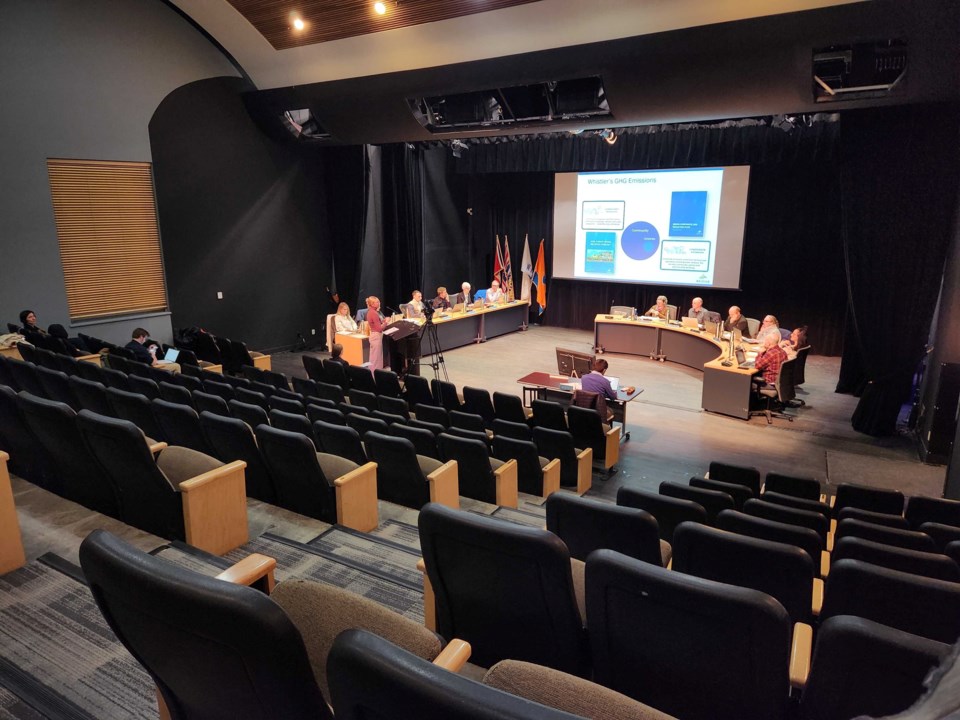Whistler’s mayor and council got a sweeping update of the municipality’s broad "Big Moves" climate action strategy on March 5, with staff delivering updates across six priorities and climate adaptation measures—though the takeaway was that Whistler as a whole is not meeting its climate targets.
It’s also apparently not meeting the threshold of community interest, either—there was only one resident in attendance to hear the progress report on Whistler’s journey to reducing its greenhouse gas emissions to 50 per cent below 2007 levels by 2023.
Climate action coordinator Maria Thorlakson delivered an overall summary of the Resort Municipality of Whistler’s (RMOW) six “big moves,” but together with environmental coordinator Tina Symko, they cautioned that overall, more work is needed.
“Whistler is not on track to meet its 2030 greenhouse gas emissions reduction targets,” said Symko.
“Further work is needed to move actions that will meaningfully shift this trajectory. In the meantime, continued progress in our adaptation goals is critical to increase Whistler’s resilience to the local impacts of climate change.”
Delving into the six big moves, Thorlakson said big moves two and four—which respectively are focused on decarbonizing transportation and building zero-emissions buildings—have seen the most progress.
“Fall of 2023 was a big time for EV chargers in Whistler,” said Thorlakson, listing the installation of 14 Level 2 chargers in day lot four as well as at the Meadow Park Sports Centre.
Big move two will see more developments in 2024, with electric fleet procurement top of the bill—three new EVs will join the fleet this year, along with more EV charging infrastructure.
Big move four saw lots of progress too, and covered the RMOW’s adoption of a zero-carbon step code for new buildings, introduced in January.
Notably, the municipality has a $200,000 grant to support an “energy advisor” position that would be focused on supporting implementation of the RMOW’s various initiatives and continuing industry engagement.
On the flipside, big moves one and three need more attention.
“We really need to double down on efforts and continue to allocate resources,” said Thorlakson.
“A lot of the actions that sit within these moves are big, complex things that require partnerships with several stakeholders, complex funding with several stakeholders as well.”
Big move one is moving commuters away from private vehicles, and big move three is visitor emissions—making them very large files.
It is not all gloom, however—Thorlakson reported staff continue to close gaps in the Valley Trail network to make it easier for people to get around Whistler by bike or on foot, while 2023 was the first full season with an electric bike-share program in the community,(which saw positive numbers for the season).
A coming report on the RMOW’s Active Transportation Strategy will also shed more light on work to do, while the municipality has applied (and funded its portion) to expand public transportation by 7,650 hours for the 2024-25 season—though this requires the province to agree, and show up with the money.
Big moves five and six are related to improving the efficiency of existing buildings, and reducing waste. Both of them are seeing ongoing work.
Symko also gave an update on efforts to adapt the RMOW to the various threats posed by climate change, with works progressing in three areas: minimizing the threat of wildfires; increasing built infrastructure resilience (flood risk); and protecting local ecology.
“It’s clear that adapting to climate change is critical for the continued safety and well-being of our community,” said Symko.
In questions from council, Councillor Jessie Morden asked whether there was movement on adding a bike lane to the highway, and was told the Active Transportation Strategy will include work on that file, while general manager of climate action, planning and development services Dale Mikkelsen said staff are engaging with the ministry of transportation and infrastructure, as the highway is a provincial responsibility, and more information is forthcoming.
Mayor Jack Crompton asked about the elephant in the room—why the RMOW and Whistler are missing their climate targets.
Thorlakson said a lot of it is to do with timing.
“A lot of the things we’ve accomplished probably won’t see the emissions reductions immediately,” she said.
“The zero-carbon step code is huge, but that’s for buildings being built now and in the future, so those are emissions reductions we see in the future.”
She added many of the files are still being worked on, and take a lot of collaboration to action.
Community and stakeholder engagement will also be key.
“They’re complex issues that we need all of our community partners involved and engaged in,” said general manager of community engagement and cultural services, Karen Elliott.
“This year we are taking the time to figure out what that approach should be in our conversations and our own internal planning, because we’re not going to reach these targets if everyone thinks it’s up to the RMOW,” she said.




